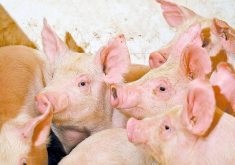Recent research by Dr. Denise Beaulieu at the Prairie Swine Centre suggests that the response of newly weaned pigs to two dietary regimes based on a simple low-cost diet and a more complex and therefore higher-cost diet is not affected by either birth weight or creep feeding. And, surprisingly, pigs fed the more complex diet for either one or four days after weaning did not perform better than those fed the simple, low-cost diet.
“The period immediately post-weaning is characterized by problems such as low feed consumption, poor growth rate, and increased incidence of diarrhea,” says Beaulieu. “Reducing the interval between weaning and resumption of feed consumption can mitigate these issues, thus the piglet must be encouraged to begin consuming solid feed upon entering the nursery.”
Read Also

Horns aren’t unlocking anytime soon on livestock transport standards
Standards good enough meet the definition of “humane” animal transportation still vary widely between what what industry wants, what animal rights advocates want and, between the two, what federal regulators decide is good enough.
The objective of her trial was to examine factors which may ecourage resumption of solid feed in the nursery, such as provision of creep feed in the farrowing room, diet quality and piglet body weight at weaning. Over a 15-week period, pigs weaned at 28 days were weighed and the 24 heaviest and 24 lightest pigs were assigned to a pen, with four pigs per pen. Half of the litters had been provided with creep feed in the farrowing room from day 21 to weaning. Within each body weight grouping, these six pens were then assigned to one of three treatments (Table 1).
“Thus each week there were six pens of the heaviest and six pens of the lightest pigs and two pens per treatment per weight group,” notes Beaulieu. “Care was taken to ensure that the time between the removal of the piglets from the sow and access to feed in the nursery was the same for all piglets and all weeks.” Video recording was used to identify which pigs consumed feed and when.
“Diets were formulated to meet or exceed amino acid, energy, vitamin and mineral requirements for pigs of this age and body weight,” says Beaulieu. “The ‘complex’ diet used corn instead of corn DDGS and contained whey, plasma, blood meal and fish meal, while the ‘simple’ diet met requirements using wheat, soybean meal, canola meal and corn DDGS.”
At November 2010 ingredient prices, the “complex” diet cost $723 per tonne and the “simple” diet $344. “While both diets met all the nutrient requirements for piglets of this age and weight, ingredients in the complex diet should supply additional benefits such as improved palatability and aiding the immune system,” she says. “We hypothesized that the complex diet would be especially beneficial for lightweight piglets and those that had not received creep in the farrowing room.”
Comparing treatments
The three treatments were A; the complex diet only on day one, B; the complex diet on the first four days, followed by the simple diet and C; the simple diet throughout (Table 1).
“Surprisingly, dietary regime had no effect on piglet performance during the first 14 days in the nursery,” says Beaulieu. “Weight at 14 days, average daily feed intake, average daily gain and feed conversion efficiency were all unaffected. Additionally, regardless of whether the piglets received creep in the farrowing room, or were of light or heavy birth weight, provision of either a simple or a complex diet had no effect on the same performance parameters during the first 14 days in the nursery.”
There was an interesting interaction between diet and birth weight category on growth rate immediately post-weaning.
“Piglets which were heavier at weaning lost weight during the first day post-weaning regardless of diet complexity. In contrast, piglets which were lighter and receiving a complex diet maintained their body weight.”
Beaulieu adds that piglets which were heavier at weaning were still heavier by day 14, however, their rate of gain was actually less than the lightweight piglets and thus the difference between the heavy and lightweight piglets was less by day 14 than at day zero. This is apparently due to greater feed efficiency of the lightweight piglets because feed consumption was similar.
In conclusion, Beaulieu says feeding a simple diet, formulated to meet all nutrient requirements, did not reduce the growth of piglets when compared to a complex diet fed for one or four days post-weaning. Switching from a complex to a simple diet after one day reduced feed intake to a greater extent than switching after four days post-weaning, she adds. She notes that in the trial environment, where piglets were in groups of four, there was no competition for feeder space and lightweight piglets performed as well as the heavyweight piglets.
“This indicates that environmental factors such as feeder access need to be examined in order to improve the poor performance of smaller pigs experienced on commercial farms,” she suggests. “We are currently carrying out another trial to re-examine the response to creep feeding in a more commercial setting.
“The complex diet was approximately $380 per tonne more than the simple diet,” Beaulieu points out. “Feeding regime B would cost about $0.35 more per piglet than A, and $0.38 more per piglet than feeding regime C. We expect this difference to be greater if the piglets are housed in a more competitive environment and have a less-than-ideal health status.”














